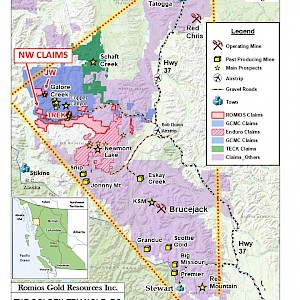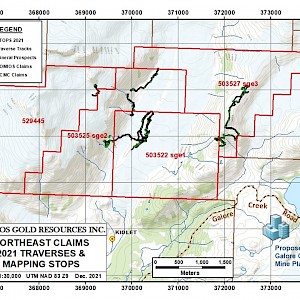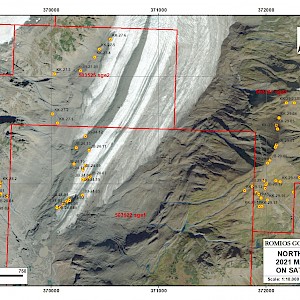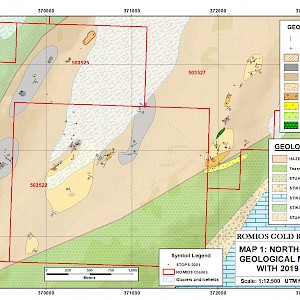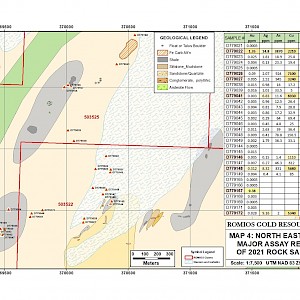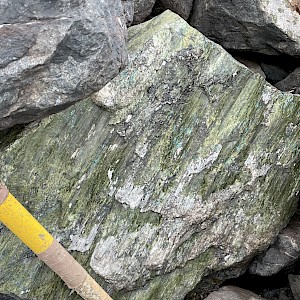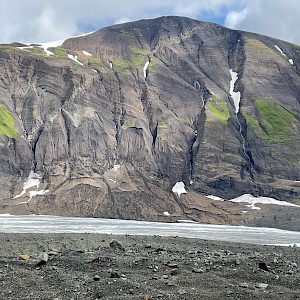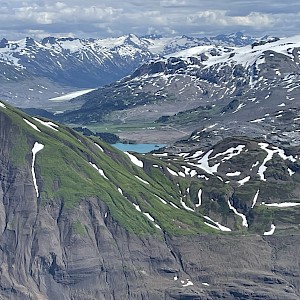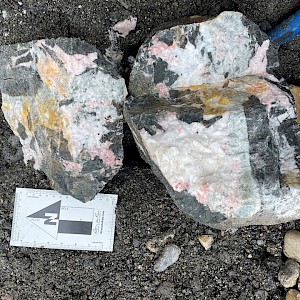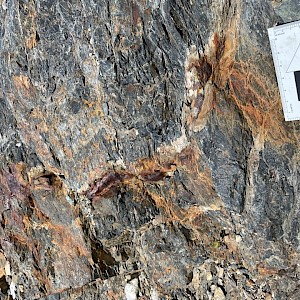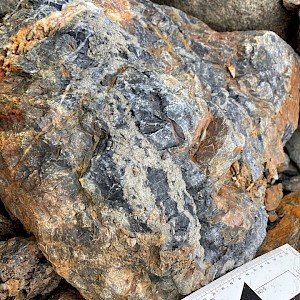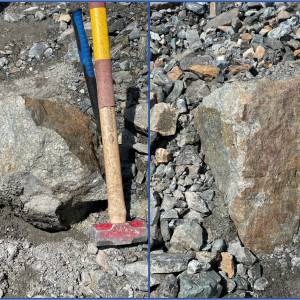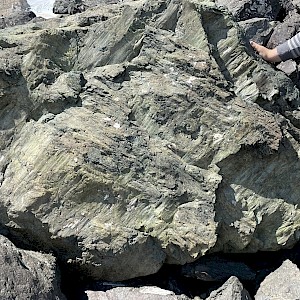Northeast Claim Block
-
Overview
Property Type- Various mineralized boulders and a large area of pyritic shales that may indicate potential for SEDEX or VMS style mineralization as well as epithermal Au-Ag.
- The geology of most interest on the claim is a NE-SW trending, fault-bounded wedge of Jurassic age Hazelton Group sedimentary and lesser volcanic rocks in contact with Triassic-Jurassic volcanic rocks to the southeast and Pennsylvanian Stikine Assemblage volcanics and sediments to the northwest.
Size- 1,670 Hectares
Status- 100% owned
Exploration Stage
Romios’ work on the North East claims over the past ~15 years has consisted primarily of mapping and prospecting programs every few years as a central glacier has continued to recede and expose more of the favourable stratigraphy. The 2021 work discovered the most mineralized boulders and the most interesting outcrops to date.
The geology of most interest on the claim is a NE-SW trending, fault-bounded wedge of Jurassic Hazelton Group sedimentary and lesser volcanic rocks in contact with Triassic-Jurassic volcanic rocks to the southeast and Pennsylvanian Stikine Assemblage volcanics and sediments to the northwest. Many of the major mineral deposits in the Golden Triangle are close to the lower Hazelton contact.
The 2021 work discovered a number of well mineralized boulders including massive pyrite veins with several per cent chalcopyrite, quartz vein boulders that assayed up to 9.4 g/t Au, plus an intriguing epithermal-style manganocalcite boulder with disseminated pyrite and minor copper enrichment. A large area of previously unmapped black shales with locally abundant pyrite and trace chalcopyrite was mapped on the west side of the glacier. These shales are assumed to be part of the Hazelton Group and warrant further work to determine if they are the distal portion of a VMS/SHMS or SEDEX mineralizing system.
Location
The North East claims adjoin the north side of Sphaler Creek valley, the location of the partially built access road from Highway 37 to Galore Creek, and 2 km from the proposed site of the Galore Creek mill complex.
-
Geology/Exploration
Highlights Of Key Target Areas
The 2021 mapping and prospecting program returned the most significant assay results from any samples ever collected on the North East claim by Romios or other parties that we know of. These results came from a number of boulders scattered along the east-facing slopes on the western side of the main central glacier and these rocks presumably came from outcrops higher up the steep mountainside. A few may have been transported some distance southward by the glacier as well.
- Several large boulders of semi-massive pyrite not only contain significant copper, 1,110 to 7,100 ppm Cu, but also highly anomalous arsenic, mercury, antimony and vanadium, suggestive of a potential epithermal vein system.
- Another pyrite boulder assayed 1.35 g/t Au, 15 g/t Ag, 0.22% Cu with highly elevated As, Hg, Sb and V.
- A striking manganocalcite boulder discovered in the same area assayed 0.11% Cu and may be related to a potential epithermal system.
- A quartz-pyrite vein assayed 2,700 ppm Sb (suggestive of an epithermal system), plus 8 g/t Ag, 0.3 g/t Au, 430 ppm Co and 5,680 ppm Cu.
- A sample of shale with a chalcopyrite veinlet assayed 0.69% Cu and 7 g/t Ag.
- A quartz boulder north of the sulphide rich samples assayed 9.38 g/t Au.
The unexpected discovery of an extensive area of pyritic shales west of the glacier is also considered encouraging in spite of the generally low assay results. Barren pyrite in shales may still be part of the distal portions of sediment-hosted exhalative base metal deposits or VMS deposits. Several of the shale samples contain quite elevated levels of phosphorous, up 5,110 ppm P, which can be indicative of SEDEX environments.
The amount of epidote alteration observed in the andesites on the western ridge top and boulders shed downhill from that area is impressive but at this point it is unknown if this is metamorphic epidote or if any could be related to hydrothermal, potentially porphyry-style alteration. No indications of plutonic activity or porphyry-style alteration has been found on the claims so far. If there is a porphyry system present on these claims it may be obscured under the large icefields/glaciers and limestone on the westernmost claims.
PAST WORK
2007: Romios contracted Fugro Airborne Surveys Corp. to conduct a helicopter-borne DIGHEM EM and magnetics survey over the entire claim block. The survey consisted of 73 line kilometers and was helpful in broadly delineating the major assemblages on the property.
2010-2019: Several brief exploration programs covering the eastern ridge and valley bottom were performed by Romios crews from 2010 to 2019, each comprising prospecting, mapping, and geochemical rock sampling with little success locating any significant mineralization either in outcrop or boulders until the 2021 program.
Conclusions
The results of the 2021 mapping and prospecting program returned the most significant results to date on the North East claims. Multiple boulders with good grades of Au, Ag and Cu were located, many with elevated levels of metals typically enriched in epithermal vein systems (Sb, As, Hg, V, etc.). The source of these boulders is yet to be located but is presumed to be farther north along the central valley. The discovery of an extensive area of pyritic shales is also considered potentially significant as they may represent the distal portion of a SEDEX or VMS style base metal deposit. A limited sampling and prospecting program was conducted in 2022, primarily in the area of the 2021 discovery of a quartz vein boulder that assayed 9.38 g/t Au. Numerus samples were collected in this same area in an effort to narrow down the potential source area of that mineralized vein; assays are pending. A larger, more thorough program of mapping and sampling is recommended to follow-up on the 2021 discoveries.

